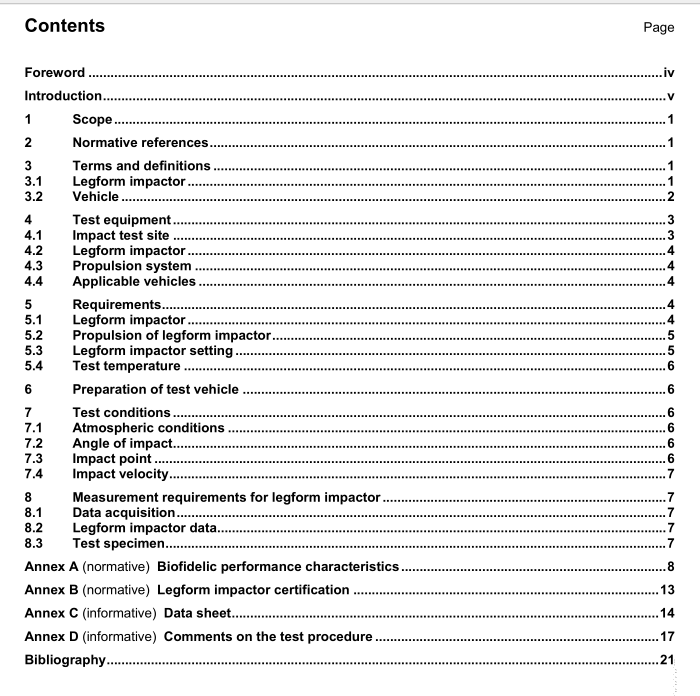ISO 11096 pdf download

ISO 11096 pdf download Road vehicles — Pedestrian protection — Impact test method for pedestrian thigh, leg and knee
e)Total legform impactor mass: (13,4土0,1) kg.f)Thigh mass including skin and foam: (8,6±0,1) kg.g)Leg mass including skin and foam: (4,8±0,1) kg.
h)Moment of inertia around y axis of leg: (0,12±0,001) kg m2.i)Moment of inertia around y axis of thigh:(0,127±0,001) kg m2.
i) An adaptor may be fitted to the top of the thigh to permit the attachment of the legform impactor to the
propulsion system. lf used, the thigh with adaptor shall still comply with the thigh requirement of mass,centre of gravity and moment of inertia.
k)There shall be a simulation of flesh or skin on the outer surface of the legform impactor. This material
shall be human-like.
5.1.2Shape of legform impactor
The shape of the legform impactor shall be cylindrical.The outer diameter of the thigh and that of the leg shallbe the same: (120土 10) mm, including a “flesh” thickness of (30±5) mm.
5.1.3 Biofidelic performance characteristics
The legform impactor shall meet the biofidelic performance targets given in Annex A.5.1.4Certification of legform impactor
The legform impactor shall meet the certification requirements given in Annex B.5.1.5Calibration of legform impactor deformable elements
Once the structural design of the deformable knee element meeting the requirements specified in 5.1.3 and5.1.4 is completed, the designer of the legform impactor shall provide a calibration test procedure in whicheach batch of deformable knee elements shall be checked to see if their performance is acceptable.Such acalibration test procedure may be applied statically if this test proves that the characteristics of the batch aresimilar to those of the original design. The response adopted as a requirement for a calibration test shouldallow for a reasonable variation in production.
5.2Propulsion of legform impactor
The legform impactor shall be propelled in free flight into the stationary test vehicle. The method of legformimpactor propulsion is at the discretion of the test office; however, the knee joint should be supported duringlegform impactor acceleration. The trajectory of the legform impactor shall be parallel to the ground within ±6at impact with the vehicle, and its angular velocity at this time shall be less than 50’1s. Because of the effect ofgravity and depending on the length of free flight, this may require that the trajectory of the legform impactor atthe time of its release from the propulsion system be at an angle above horizontal. There shall be no contactbetween the legform impactor and the propulsion system during impact with the vehicle.
5.3 Legform impactor setting
5.3.1 The legform impactor shall be straight,and vertical in pitch and roll at the time of impact (seeFigure 2).The tolerances for pitch,roll and yaw shall be ± 5°.
5.3.2The lower end of the legform impactor shall be at or within 10 mm of the level of the ground referenceplane(GRP) at impact with the vehicle. The legform impactor shall not come into contact with the groundduring impact (see Figure 2).
5.4Test temperature
The legform impactor shall have a temperature of (20±5)°℃ at the time of impact. However,a narrowerrange may be required to keep the performance of the legform impactor within the specified limits.
6 Preparation of test vehicle
6.1Either a complete vehicle or cut-body shall be used for the test. All parts of the vehicle structure andcomponents that could be involved in a pedestrian leg impact shall be in place.
6.2The ground clearance of the test vehicle or cut-body shall be set to simulate that of an actual vehiclewith tyres inflated to the nominal tyre pressure specified by the manufacturer.Spacers may be placed underthe tyres in order to bring the vehicle to a height that will allow the free flight of the legform impactor.
NOTE Testing with or without numberplate (licence plate) is at the discretion of the test laboratory or governmentbody. The material and size of the plate may be standardized during a given test programme when testing a vehicle withplate.
6.3For tests of a complete vehicle, the suspension shall be set to the normal ride height attained at the testimpact velocity (specified in the relevant laws and regulations or by the concerned government agencies) andshall include the complete vehicle kerb mass (ISo-MO6) in accordance with ISO 1176, with one adult male50th percentile dummy or an equivalent mass placed on the drivers seat, and with one adult male 50thpercentile dummy or an equivalent mass placed on the passenger’s seat.
6.4For tests using a cut-body, the height of the body above the ground reference plane shall be the sameas that of the complete vehicle loaded in accordance with 6.3.
6.5 The parking brake shall be applied, or the cut-body shall be securely mounted.
6.6Sufficient time shall be allowed for the temperature (see 7.1) of all vehicle components to stabilizebefore testing.
7Test conditions
7.1Atmospheric conditions
Relative humidity, atmospheric pressure and temperature shall be measured at the time of the test andrecorded in the test report.









